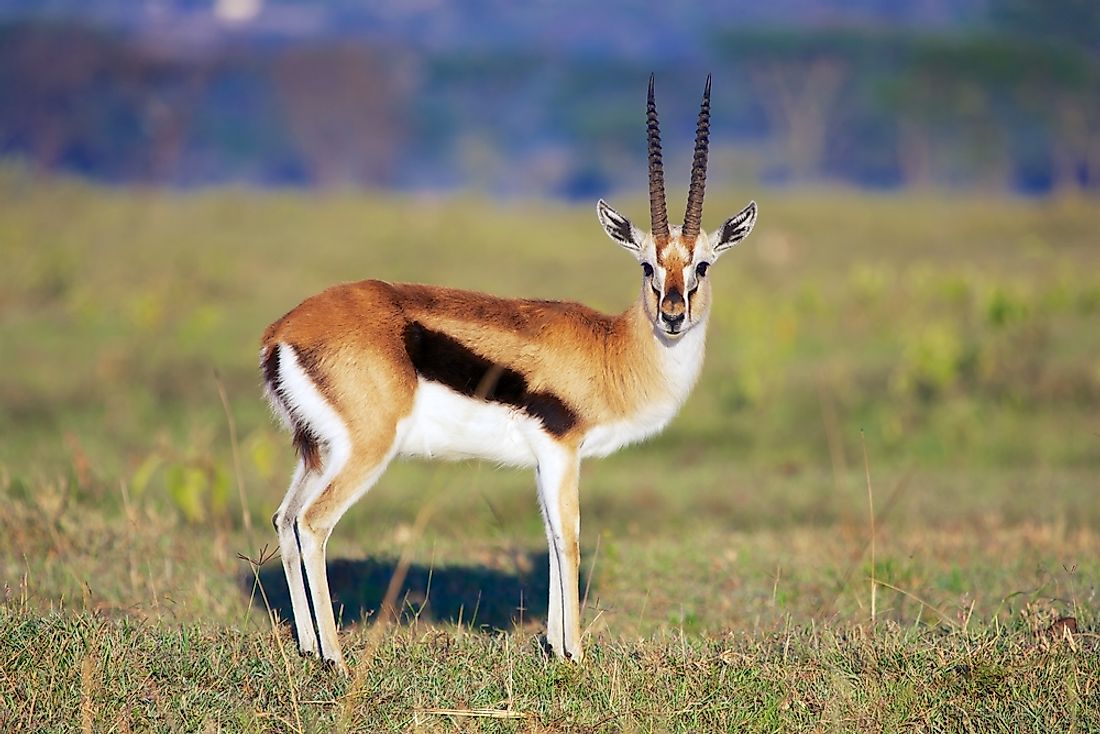Gazelle Facts - Animals of the World

4. Physical Description
The name gazelle is borrowed from the Arabic word “gazal”. It was often used in love poems in ancient Persia. Apart from being a symbol of love, the gazelle was also associated with female beauty in Arabic literature. This was in relation to its feature of being a graceful animal. The theme of love was also borrowed from the Hebrew poetic book found in the Christian Bible known as the “Song of Songs” (8:14).
The gazelle is grouped in the same family as cattle, goats and sheep. It resembles the deer and antelope. There are about 19 species of gazelles that exist in the world. Small gazelles include the Thomson’s gazelles and the Speke’s gazelle. These gazelles weigh 12-75 kg and are between 51 and 109 cm tall. On the other hand, the largest gazelle is the Dama gazelle. It weighs 40-75 kg and has a height of 137-168 cm. Gazelles are light and swift which allows them to run away from their predators. Gazelles have small heads, large eyes and ears, and narrow muzzles. They also have a strong sense of hearing, sight, and smell which they use to make up for their vulnerability in their wild habitats.
Other species of gazelles include Grant’s gazelle, Mhorr gazelle, Edmi gazelle, Cuvier’s gazelle, Goitered gazelle, Chinkara, Dorcas gazelle, and Soemmerring’s gazelle. The most popular species of the gazelle is the Thomson’s gazelle which is mainly found in African savannas. Gazelles are usually tan or reddish brown in color and they have distinctly curved and ringed horns. The male gazelles have long horns that are marked by 20 rings and curved backwards. The female gazelles may either have small and short horns or no horns at all. Amongst all species of gazelles, the Edmi gazelle horns grow the longest and can reach 35.5 cm long. The male gazelles are referred to as “bucks” while the female gazelles are known as “does.”
3. Diet
Gazelles are herbivores who only feed on vegetation. They feed on grass, shoots, and leaves. Whenever they want to reach leaves from high branches, gazelles have the ability to stand on their back legs. Young gazelles need a high amount of water for their survival. However, once they are able to fend for themselves, they adapt to using little water or no water at all. In fact, some gazelles can live their life without drinking water. The water used by their bodies is extracted from the plants they feed on. Since it is difficult for predators to attack gazelles if they are in herds, the animals will often feed on grassland in herds. Feeding near zebras and wildebeests is also common.
2. Habitat and Range
Gazelles often live in hot and dry savannas and deserts which can be found in places like Africa and Asia. They can also be found in southwest and central Asia as well as in India. The animals prefer to inhabit shrubs and grasslands. To survive the hot weather, gazelles shrink their heart and liver which allows them to stay hydrated. Doing so enables them to lose less water from their bodies so they can retain most of it. Male gazelles protect their territories by either laying droppings in their areas of interest or spraying scent on the tall grass surrounding their habitat. If their territories are challenged, male gazelles lock horns with their opponent in defence. The winner takes the possession of the territory. Farming, loss of habitat, and hunting threatens gazelles' existence.
1. Behavior
Gazelles are social animals that live in groups composed of as many as 700 members. Sometimes, females and males live in separate groups. For instance, the female Thomson's gazelles live in groups of 10-30 with their young. As soon as the young become of age, the males join a group called a bachelor's herd. Gazelles have a gestation period of 6 months, after which they give birth to one or two fawns. They give birth twice per year and their breeding season occurs during the rainy season of the year which ensures the calves have plenty of water to drink. Due to the high amount of gazelles dying from predators, giving birth twice per year is essential to the animals. It also brings balance to the ecosystem because a higher number of herbivores compared to carnivores is needed. Gazelles have a life span of 10-15 years.
If looming danger is present, gazelles have an interesting way of warning each other. When they sense the presence of another animal, they will either flick their tail or stomp their feet. The rest of the herd will understand the signal and take cover. For large animals such as cheetahs and lions, gazelles are considered prey. Gazelles can run at very high speeds which can reach 100km/hr. They have adopted a leaping style known as "stotting" which involves springing into the air with all four feet. At this high speed, a gazelle can even outrun a cheetah. Due to its ability to run at such a high speed, predators will often approach a gazelle stealthily and catch it by surprise. Young gazelles hide in tall grass which helps to protect them from danger.











